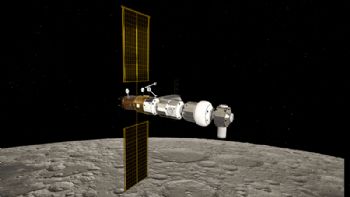
This autumn is seeing a number of experiments ‘controlling robots from afar’, with European Space Agency (ESA) astronaut Luca Parmitano directing a robot in the Netherlands and engineers in Germany controlling a rover in Canada.
The Agency (
www.esa.int) said: “Imagine looking down at the Moon from the Gateway — the next structure to be launched by the partners of the International Space Station — as you prepare to land near a lunar base to run experiments, but you know the base needs maintenance work on the life-support system that will take days.
“It would be better to maintain the base from orbit, so the astronauts can get straight to work once on the Moon.
“Human-robotic partnerships are at the heart of ESA’s exploration strategy, which includes preparing for scenarios like this by sending robotic scouts to the Moon and planets, hand-in-hand with astronauts controlling them from orbit.”
The ESA’s Meteron project (Multi-Purpose End-To-End Robotic Operation Network) was formed to develop the technology and know-how needed to operate rovers in these harsh conditions.
It covers all aspects of operations — from communications and the user interface to surface operations — and even connecting the robots to the astronauts by sense of touch.
The first experiment took place in 2012, when NASA astronaut Sunita Williams controlled a LEGO rover in Germany to test a newly developed ‘space internet’ that proved it is possible to control a rover from orbit.
“This is no easy feat, as signals from the International Space Station make a round trip of 144,400km.
The ‘outpost’ moves around Earth at 29,000kph, signals travel up to satellites (almost 36,000km high) and then down to a US ground station in New Mexico, via NASA Houston and through a transatlantic cable to Europe — and back!”
From initial tests, larger rovers such as Eurobot were controlled from space, while teams at ESA’s technical centre in the Netherlands started experimenting with haptic feedback, allowing astronauts to feel what the robot touches.
In 2015, a ‘historic orbital handshake’ occurred between NASA astronaut Terry Virts and a person on Earth over 5,000km away.
Just a few months after that milestone, ESA astronaut Andreas Mogensen controlled a rover, enabling it to insert a metal peg into a round hole in a ‘task board’ with millimetre precision, simulating the repair of an electrical connection.
In November, the Meteron project will put all the elements together, when ESA astronaut Luca Parmitano operates the Interact rover in the Netherlands from the International Space Station.
This experiment, dubbed Analog-1, will combine all the know-how from a decade of the Meteron project into a full-scale test: operating a rover from orbit to collect samples of lunar rock.